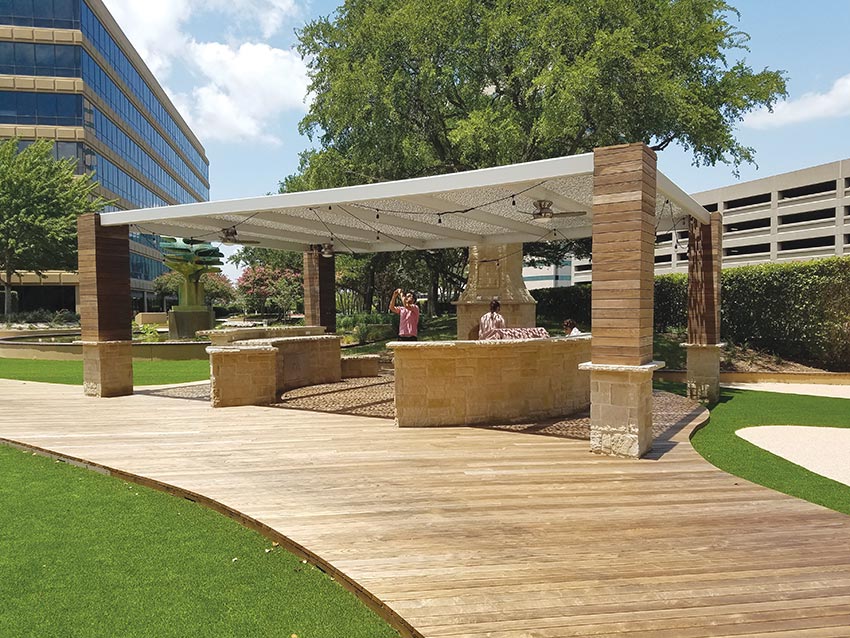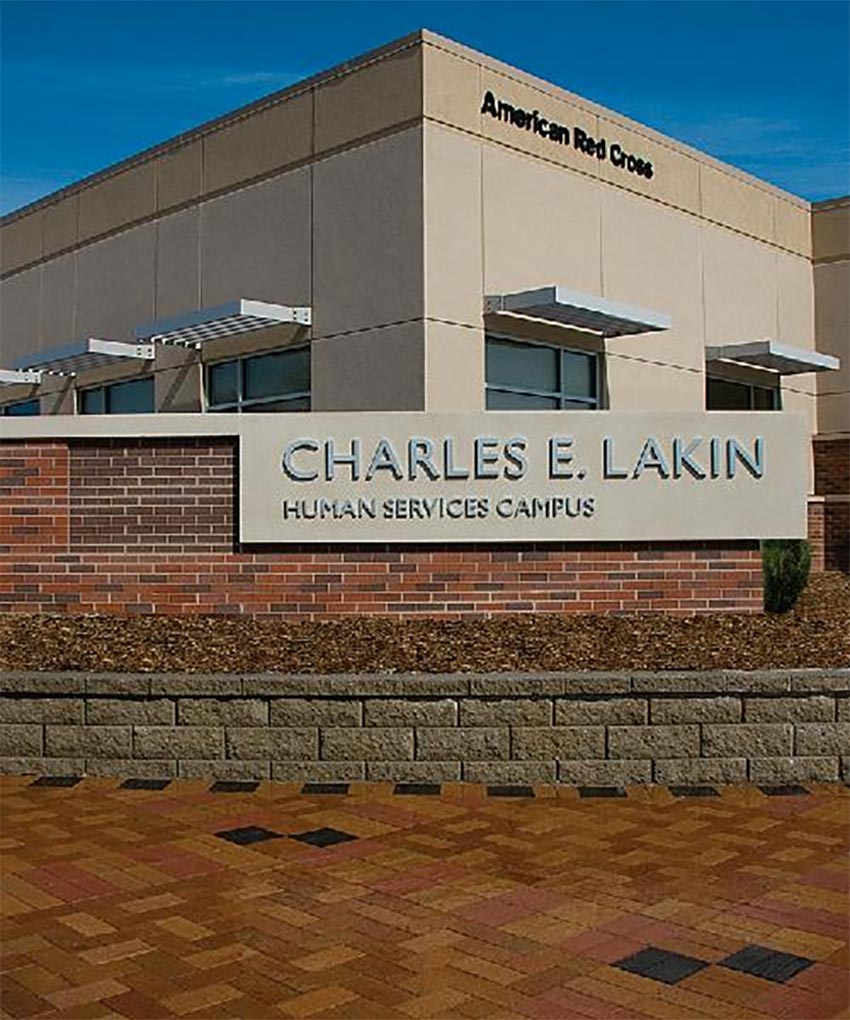This CE Center article is no longer eligible for receiving credits.
Landscape architecture shapes the built environment in ways beyond plant materials. The Whole Building Design approach optimally includes landscape architecture as a key component. The overall goal of Whole Building Design is to create a successful building project by utilizing an integrated design approach that incorporates all design disciplines during the planning and programming phases of a project. Some of the key design objectives of Whole Building Design are sustainability, accessibility, aesthetics, and performance durability.

Photo courtesy of Bison Innovative Products
The Symphony House Apartments utilized a pedestal deck system and modular aluminum planters to create this green roof.
How the building sits within the landscape sets the context for its construction and use. Landscape architectural design helps the building interact with its physical location, as the look and feel of the site is greatly influenced by the hardscape surfaces, site features, plantings, and exterior spaces that comprise the environment around a building. This course will provide insight into design approaches and materials that assist landscape architects with a Whole Building Design team approach.
The course will also reference some of the relevant criteria toward achieving points through LEED, SITES, and WELL certifications. It will illustrate ways that designers can achieve LEED, SITES, or WELL points by minimizing impacts to existing site ecology, using products that help to conserve ecosystems, utilizing products that come from renewable resources, avoiding waste through the use of recycled materials, and managing the effects of climate, whether excessive heat or excessive rain, through design techniques and products that mitigate climate issues.
Creating an outdoor space that is able to effectively weather the elements, meet its design purpose, and appreciate the owner’s need for low maintenance costs can be invaluable to a designer. This course will explore the ways that designers can create an attractive and sustainable outdoor environment compliant with several LEED, SITES, and WELL criteria while providing a Whole Building Design approach to a project.
Design Flexibility from Ground to Roof
Modular deck and pavement systems provide landscape architects with the design flexibility to create both rooftop environments and outdoor ground-level amenity spaces. Rooftop and ground-level spaces can be designed using wood, stone, structural porcelain, artificial turf, grating, or concrete to create unique custom looks. All of these materials can be applied either over a prepared subgrade or rooftop when utilizing a deck support system. Deck supports, also known as pedestals, create level surfaces over sloped areas. Pedestal deck systems can help reduce the heating and cooling loads of a building because they are “air permeable.” Air permeability is defined as the rate of airflow passing through a given area of a material. Pedestal deck systems allow for greater airflow on a roof. This reduction of heating on building roofs helps to meet LEED and SITES criteria for reduction of the heat island effect. Pedestal deck systems also help to increase walkable pedestrian surfaces on roofs and uneven ground spaces, thus meeting the criteria for SITES 6.5 – Support Physical Activity and LEED Sustainable Sites 5.2 – Site Development – Maximize Open Space.
Versatile Pedestal Deck Systems
Pedestal deck systems can be utilized over any structural surface: on structural concrete rigid insulation or roof membranes for rooftop decks, plazas/terraces, compacted grade, pavements, pool surrounds, or within water features. These pedestal deck systems are comprised of two major components: pedestals and tiles/pavers. Pedestals are designed to elevate and support a variety of surfaces, including structural porcelain, stone, granite, or concrete pavers, wood tiles, composite materials, fiberglass grating, or conventional joist and plank systems.

Photo courtesy of Bison Innovative Products
Shown here is an installation of a pedestal deck system supporting ipê wood tiles on a rooftop deck.
Pedestal deck systems offer tremendous design flexibility coupled with ease of installation. The adjustable pedestal deck systems provide a unique and viable alternative to traditional deck building materials and methods for the following key reasons:
- They are available in a range of heights and weight bearing capacities to suit a variety of applications.
- They are one of the most labor- and cost-efficient methods of creating a flat, level deck over a sloped surface.
- They use a gravity system that protects the roofing and waterproofing materials without damaging or harming the surface below.
- They can support decks over occupied space, allowing space for electrical systems, duct work, or irrigation.
Pedestals are made with high-density polypropylene plastic (comprised of 20 percent post-industrial recycled content) that are 100 percent recyclable. The recycled material content of the pedestals provides points toward both LEED and SITES certification. Pedestals are screw adjustable and easily leveled with tapered base levelling discs and/or shims, allowing the creation of level rooftop decks over a variety of surfaces, including sloped surfaces. Pedestals can elevate and support wood tiles, concrete pavers, and a variety of other surfaces when sophisticated, commercial-grade decking is required. They are also sturdy enough to support site furnishings such as planters, tables, and benches.
Design Options using Pedestal Deck Systems
Pedestals come in residential, commercial, and industrial grades, with each grade having different characteristics. Deciding which systems to specify is dependent on the support and elevation requirements of the installation. Pedestal deck systems create valuable, usable outdoor space for both owners and their clients, customers, and visitors. Rooftop decks are a way for residential, hospitality, or public spaces to differentiate themselves from the competition. Incorporating a pedestal deck system can provide pedestrian access to green roofs and expand usable space to include gardens and walkways.
A pedestal deck system is an ideal solution for water-feature applications. The system conceals the water supply beneath the pedestals and surface materials and allows water to drain to the surface below for recycling. Additionally, the supports are impervious to water, mold, and most chemicals.
Designs can include recessed lighting in the pedestal deck system. The lighting will enhance the ambiance of the environment and improve visibility and safety during nighttime and/or dark conditions.
Ground- and street-level sidewalks and storefronts can be expanded through the design of small deck areas known as parklets, or pop-up parks, all of which enhance urban areas. These parklets and pop-up parks can be designed using pedestal systems and modular wood tiles placed over existing ground- and street-level spaces. These exterior spaces provide areas that support social connections, mental restoration, and physical activities, which are criteria under Site Design – Human Health and Well-Being for SITES and Community, Movement, and Mind for WELL.
Fastening kits and splines facilitate quick and secure pedestal deck system installations. The fasteners attach kerf-cut wood tiles, concrete, and stone pavers or paver tray-backed 2-centimeter porcelain pavers to the pedestals without penetrating or damaging the roof surface material. While the fasteners are hidden, they can be accessed to allow for the removal of individual wood tiles or pavers if roof maintenance, drain access, or replacement is required. Some pedestal deck systems are designed to resist wind uplift; consult individual manufactures for more information about their systems.
Landscape architecture shapes the built environment in ways beyond plant materials. The Whole Building Design approach optimally includes landscape architecture as a key component. The overall goal of Whole Building Design is to create a successful building project by utilizing an integrated design approach that incorporates all design disciplines during the planning and programming phases of a project. Some of the key design objectives of Whole Building Design are sustainability, accessibility, aesthetics, and performance durability.

Photo courtesy of Bison Innovative Products
The Symphony House Apartments utilized a pedestal deck system and modular aluminum planters to create this green roof.
How the building sits within the landscape sets the context for its construction and use. Landscape architectural design helps the building interact with its physical location, as the look and feel of the site is greatly influenced by the hardscape surfaces, site features, plantings, and exterior spaces that comprise the environment around a building. This course will provide insight into design approaches and materials that assist landscape architects with a Whole Building Design team approach.
The course will also reference some of the relevant criteria toward achieving points through LEED, SITES, and WELL certifications. It will illustrate ways that designers can achieve LEED, SITES, or WELL points by minimizing impacts to existing site ecology, using products that help to conserve ecosystems, utilizing products that come from renewable resources, avoiding waste through the use of recycled materials, and managing the effects of climate, whether excessive heat or excessive rain, through design techniques and products that mitigate climate issues.
Creating an outdoor space that is able to effectively weather the elements, meet its design purpose, and appreciate the owner’s need for low maintenance costs can be invaluable to a designer. This course will explore the ways that designers can create an attractive and sustainable outdoor environment compliant with several LEED, SITES, and WELL criteria while providing a Whole Building Design approach to a project.
Design Flexibility from Ground to Roof
Modular deck and pavement systems provide landscape architects with the design flexibility to create both rooftop environments and outdoor ground-level amenity spaces. Rooftop and ground-level spaces can be designed using wood, stone, structural porcelain, artificial turf, grating, or concrete to create unique custom looks. All of these materials can be applied either over a prepared subgrade or rooftop when utilizing a deck support system. Deck supports, also known as pedestals, create level surfaces over sloped areas. Pedestal deck systems can help reduce the heating and cooling loads of a building because they are “air permeable.” Air permeability is defined as the rate of airflow passing through a given area of a material. Pedestal deck systems allow for greater airflow on a roof. This reduction of heating on building roofs helps to meet LEED and SITES criteria for reduction of the heat island effect. Pedestal deck systems also help to increase walkable pedestrian surfaces on roofs and uneven ground spaces, thus meeting the criteria for SITES 6.5 – Support Physical Activity and LEED Sustainable Sites 5.2 – Site Development – Maximize Open Space.
Versatile Pedestal Deck Systems
Pedestal deck systems can be utilized over any structural surface: on structural concrete rigid insulation or roof membranes for rooftop decks, plazas/terraces, compacted grade, pavements, pool surrounds, or within water features. These pedestal deck systems are comprised of two major components: pedestals and tiles/pavers. Pedestals are designed to elevate and support a variety of surfaces, including structural porcelain, stone, granite, or concrete pavers, wood tiles, composite materials, fiberglass grating, or conventional joist and plank systems.

Photo courtesy of Bison Innovative Products
Shown here is an installation of a pedestal deck system supporting ipê wood tiles on a rooftop deck.
Pedestal deck systems offer tremendous design flexibility coupled with ease of installation. The adjustable pedestal deck systems provide a unique and viable alternative to traditional deck building materials and methods for the following key reasons:
- They are available in a range of heights and weight bearing capacities to suit a variety of applications.
- They are one of the most labor- and cost-efficient methods of creating a flat, level deck over a sloped surface.
- They use a gravity system that protects the roofing and waterproofing materials without damaging or harming the surface below.
- They can support decks over occupied space, allowing space for electrical systems, duct work, or irrigation.
Pedestals are made with high-density polypropylene plastic (comprised of 20 percent post-industrial recycled content) that are 100 percent recyclable. The recycled material content of the pedestals provides points toward both LEED and SITES certification. Pedestals are screw adjustable and easily leveled with tapered base levelling discs and/or shims, allowing the creation of level rooftop decks over a variety of surfaces, including sloped surfaces. Pedestals can elevate and support wood tiles, concrete pavers, and a variety of other surfaces when sophisticated, commercial-grade decking is required. They are also sturdy enough to support site furnishings such as planters, tables, and benches.
Design Options using Pedestal Deck Systems
Pedestals come in residential, commercial, and industrial grades, with each grade having different characteristics. Deciding which systems to specify is dependent on the support and elevation requirements of the installation. Pedestal deck systems create valuable, usable outdoor space for both owners and their clients, customers, and visitors. Rooftop decks are a way for residential, hospitality, or public spaces to differentiate themselves from the competition. Incorporating a pedestal deck system can provide pedestrian access to green roofs and expand usable space to include gardens and walkways.
A pedestal deck system is an ideal solution for water-feature applications. The system conceals the water supply beneath the pedestals and surface materials and allows water to drain to the surface below for recycling. Additionally, the supports are impervious to water, mold, and most chemicals.
Designs can include recessed lighting in the pedestal deck system. The lighting will enhance the ambiance of the environment and improve visibility and safety during nighttime and/or dark conditions.
Ground- and street-level sidewalks and storefronts can be expanded through the design of small deck areas known as parklets, or pop-up parks, all of which enhance urban areas. These parklets and pop-up parks can be designed using pedestal systems and modular wood tiles placed over existing ground- and street-level spaces. These exterior spaces provide areas that support social connections, mental restoration, and physical activities, which are criteria under Site Design – Human Health and Well-Being for SITES and Community, Movement, and Mind for WELL.
Fastening kits and splines facilitate quick and secure pedestal deck system installations. The fasteners attach kerf-cut wood tiles, concrete, and stone pavers or paver tray-backed 2-centimeter porcelain pavers to the pedestals without penetrating or damaging the roof surface material. While the fasteners are hidden, they can be accessed to allow for the removal of individual wood tiles or pavers if roof maintenance, drain access, or replacement is required. Some pedestal deck systems are designed to resist wind uplift; consult individual manufactures for more information about their systems.
Modular Wood Tiles for Ground or Rooftop Applications
Typically made from dense hardwoods, wood tiles are commercial grade and available in responsibly harvested standard and FSC-certified species. Wood species include fused bamboo, cumaru, garapa, ipê, mahogany, and massaranduba. Hardwood tiles contain a rich variety of graining and coloration, are exceptionally dense, and resist insects. Wood tiles can be crafted from premium-grade remnants and are harvested in an environmentally responsible way designed to preserve the economic viability of rainforest hardwoods.
Thanks to their density, hardwood species require minimal maintenance. If maintaining the wood color is desired, wood tiles can be periodically cleaned and sealed. Left to weather naturally, the wood tiles will develop a silvery-gray patina. Because they weigh one-third as much as concrete pavers, wood tiles are a good alternative when surface material weight is a factor. The tiles can be laid in a parquet or linear pattern, or mixed with pavers, river rock, stone, plank decking, or other options to create unique aesthetics.
Because they are modular, the wood tiles meet SITES 5.3 – Design for Adaptability and Disassembly. The wood tiles also meet SITES 5.8 as they support safer chemistry.
Site Furnishings for Enhancing Landscape Spaces
Site furnishings such as benches, tables, and planters provide enhancements to any outdoor space, creating more inviting spaces for leisure activities and social interaction. Modular planters offer flexible options for the addition of plantings to roof gardens, small urban spaces, pop-up parks, and/or building plazas. Planters are available in a variety of materials, including metal, cast stone, concrete, resin, fiberglass, and wood. Aluminum planters offer the durability of metal with a lighter weight, making them easy to move and place onto rooftop decks.
Planter cubes that are constructed of lightweight, recycled aluminum are durable, low maintenance, and designed to withstand extreme temperatures. This makes them ideal for rooftop locations that are subject to extreme winds, sun, and weather. These aluminum planter cubes can be painted using an industrial-strength powder-coating technology developed with modern aesthetics in mind. Powder coating is a dry finishing process that is applied electrostatically and cured under heat, creating a more resilient finish than conventional paint. The process does not emit any volatile organic compounds (VOCs) into the air and allows the aluminum planter cubes to be coated with any RAL paint code color. (RAL is a color-matching system used in Europe to define paint, coatings, and plastics. RAL is an abbreviation for the Dutch institute that administers the color standard.) The aluminum planter cubes typically contain 20 percent recycled content, are 100 percent recyclable, include drain holes and irrigation sleeves, and are made in the United States. They come in a variety of size and color choices, providing a number of design options for landscape architects.
Wood planters provide another material option for introducing plants onto a rooftop garden or a ground-level exterior space. Ipê wood planter cubes and ipê wood planter cube tops offer a selection of modular design options to incorporate seating, storage, and planters into a ground-level or rooftop space. With the long-lasting durability of dense hardwoods, these wood planters and tops can withstand harsh environments. The warm wood tones and varied grain provide a natural complement to wood decking. The wood planter cubes may have a polyurethane lining and drainage holes, making plant care and maintenance easy. Custom sizes and species are available as well. Modular planter cubes may be used as planters or with an ipê top for seating and/or storage, providing flexibility of design options. Most planters have drain holes and irrigation sleeves that make caring for plants or vegetables convenient. As a storage unit, they can be used for seasonal items like cushions or throw pillows.
Lightweight aluminum trays expand the design options for rooftop environments. Used as a containment system for architectural rocks or other deck elements, the low-clearance aluminum trays integrate seamlessly with the modular planters and wood tiles, providing designers with a palette of materials for designing rooftop environments. Many aluminum trays are corrosion resistant, made in the United States, and available in a variety of standard and custom size options that offer modular integration with a pedestal deck system.

Photo courtesy of Thermory USA
Shown is thermally modified white ash decking board.
Design Applications for Enhancing Roof Gardens with Wood
Thermally modified white ash, spruce, and Scots pine decking, cladding, and porch flooring offer great versatility and durability as well as an environmentally sourced product for the design of rooftop decking. Each fiber of the wood board is modified, using the thermal-modification process of heat and steam to achieve rot resistance to the core of the board. This provides decking with a Class 1 durability rating. Class 1 Durability is a European rating system that classifies exterior wood products based on their resistance to rot and decay. Class 1 is the highest possible rating and it means that, without any additional maintenance and with proper installation, the wood will remain resistant to rot for a minimum of 25 years. White ash and spruce are classified as Class 1 durability. Class 2 durability ratings indicate that the wood is resistant to rot for 20 years or more. The Scots pine is classified as Class 2.
As a comparison with other wood species, ipê from Brazil and old-growth Burmese teak have Class 1 ratings, while most other tropical rainforest species attain Class 2 ratings or less. Domestic old-growth cedar can be classified as Class 2, although currently harvested cedar is mostly tertiary growth so it meets a Class 3 standard, which indicates resistance to rot for 10 years or more.
In addition to durability, thermally modified wood provides a product that has a rich, natural color that is not the result of a stain. Left untreated with UV-protectant oil, the boards will slowly age to a stunning platinum grey. In addition, each board goes through a milling process that produces an extremely smooth finish, thus eliminating roughness and splinters.
Because of its high durability and low maintenance requirements, thermally modified wood offers great versatility for the design of exterior surfaces, whether for porches, outdoor decks, or roof patios, as thermally modified wood can withstand foot traffic and harsh weather conditions and still retain its beautiful character and smooth finish.
Sustainable Woods for Durability and Aesthetics
Thermally modified white ash, scots pine, and spruce woods are sustainable alternatives to tropical woods or composites. The wood is harvested responsibly in Northern Europe (ash, pine and spruce) and North America (ash) from naturally renewable forests, making it a long-lasting alternative to tropical woods without sacrificing durability and with superior dimensional stability. The wood is responsibly harvested by sourcing from a number of different locations around the world, thus leaving each forest healthy and thriving. The wood is also shipped via ocean container, which is more fuel-efficient than rail transportation and nearly 10 times as efficient as 18-wheeler trucks.
White ash, scots pine, and spruce are chosen as most suitable species for the thermal-modification process for the following reasons:
- These are sustainable wood species that can be harvested responsibly without contributing to deforestation or damaging the environment.
- These wood species yield the best results via the thermal-modification process, achieving a Class 1 durability rating.
The thermal-modification process uses only heat and steam, creating cellular alterations that occur on both a chemical and cellular level in the wood. The sugar content and water-absorption capacity of the wood are altered in the thermal-modification process, thus modifying both cellulose and hemicellulose cells.1 Cellulose is made up of smaller units of glucose, and hemicellulose is made up of shorter carbohydrate structure, monosaccharides.2 Hemicellulose has the higher oxygen content so the cells of this cellular group can be altered by slightly burning these specific cells within the wood before burning the other cellular groups. This sequential burning process causes a reaction that creates additional heat within the wood. The thermal-modification process uses the steam to control the burning process. This produces wood boards that are rot resistant for 25-plus years. This process also produces wood with greater structural integrity of the fibers and dimensional stability. Aesthetically, it provides a simple, beautiful, timeless wood product that gets better with age.
Thermally modified wood goes through an extensive testing process for rot resistance, dimensional stability, termite resistance, strength, formaldehyde content, and flame spread. This testing ensures wood boards that are durable and resistant to rot and moisture. The testing process takes anywhere from a week to several months depending on the test. The thermal-modification process is very detailed and computer controlled to ensure the exact same result is achieved every single time the wood is processed through the testing chamber
Only select northern hardwoods from North American and European forests, renowned for their well-documented sustainable forestry practices, are used to produce thermally modified woods. This fact normally satisfies the customer’s desire for an eco-friendly product, and FSC certification becomes unnecessary. However, FSC certification is available on a special-order basis, depending on the product needed, the size of the order and whether the FSC material is available. FSC certification requires a 25 percent price premium and an extra 12–14 week lead time to source the raw material especially for the order.
Some softwoods used in the thermal-modification process are certified by the Program for the Endorsement of Forest Certification (PEFC), a European-based certification system that is not widely known in the U.S. market. These softwoods are sourced from Scandinavian forests, which are closely managed and extremely sustainable but not FSC certified.
Using Wood for Its Design Flexibility and Aesthetics
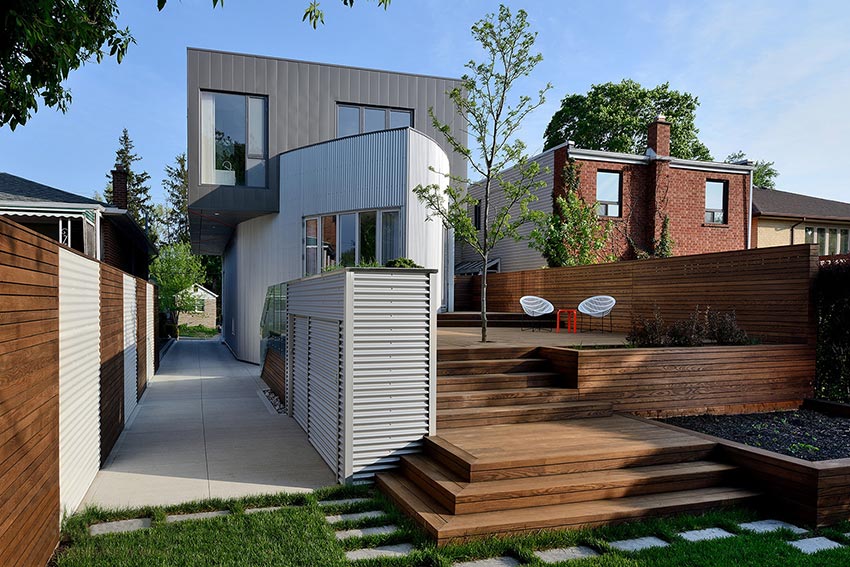
Photo Credit: Larry Arnal
Thermally modified wood was used to create multitiered decking and planters for a private residence.
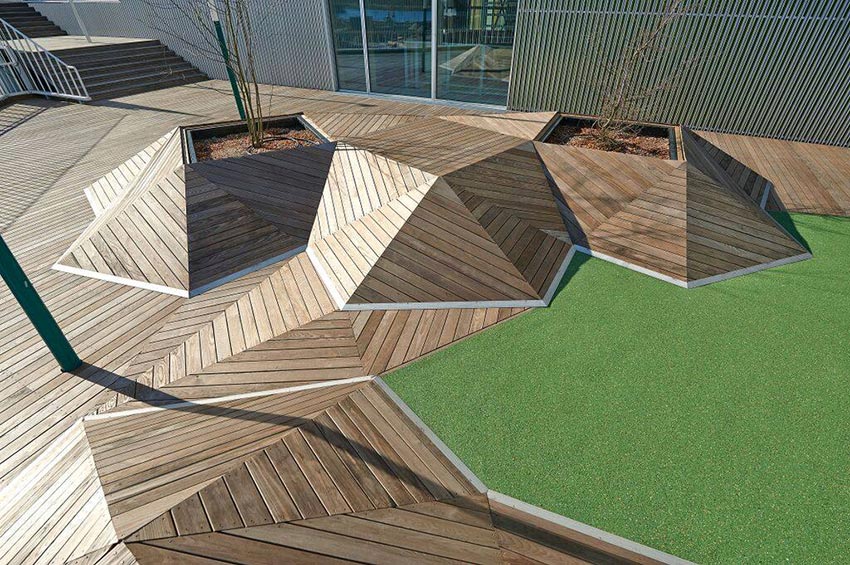
Photo Credit: Brahl Fotografi
A geometrical deck in Copenhagen was created through Thermory Estonia.
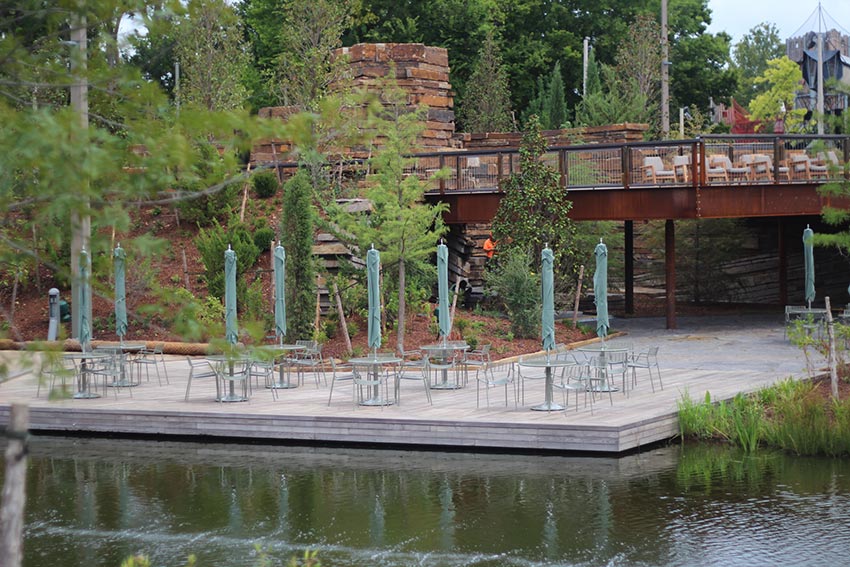
Photo: Ryoma Tominaga
The Gathering Place, a 64-acre park located just outside of downtown Tulsa, Oklahoma, was intentionally designed by Michael Van Valkenburgh Associates to bring people together and is unifying the suburban sprawl of the city. White ash decking and cladding was used for this project.
Thermally modified wood provides a material with extensive flexibility for designers. White ash thermally modified wood was used by designer Thomas Tampold of Yorkville Design Centre to create outdoor decking and raised planters at this residence in Toronto.
Scots pine decking was used by JJW Landscape Architects and Keinicke & Overgaared Architects in the design of this geometrically configured outdoor deck and planters for a project in Copenhagen, Denmark.
In each of these cases, the wood is installed quickly and easily using a custom-developed clip strip that the installer presses down on and the boards click into place. The wood boards are pre-grooved with tracks for the clips so alignment is automatic. There is no need for drill bits or screws, thus creating a clean look with no hazards to bare feet.
The residential deck in Toronto and the plaza in Copenhagen illustrate applications and uses of thermally modified wood in ground-level settings. The durability characteristics and installation procedures for ground-level settings are the same as for rooftop locations. As thermally modified wood is responsibly harvested, it is a product that meets LEED and SITES criteria for sustainable practices in materials.
Clay Pavers: An Environmentally Friendly Material to Meet Sustainability Criteria
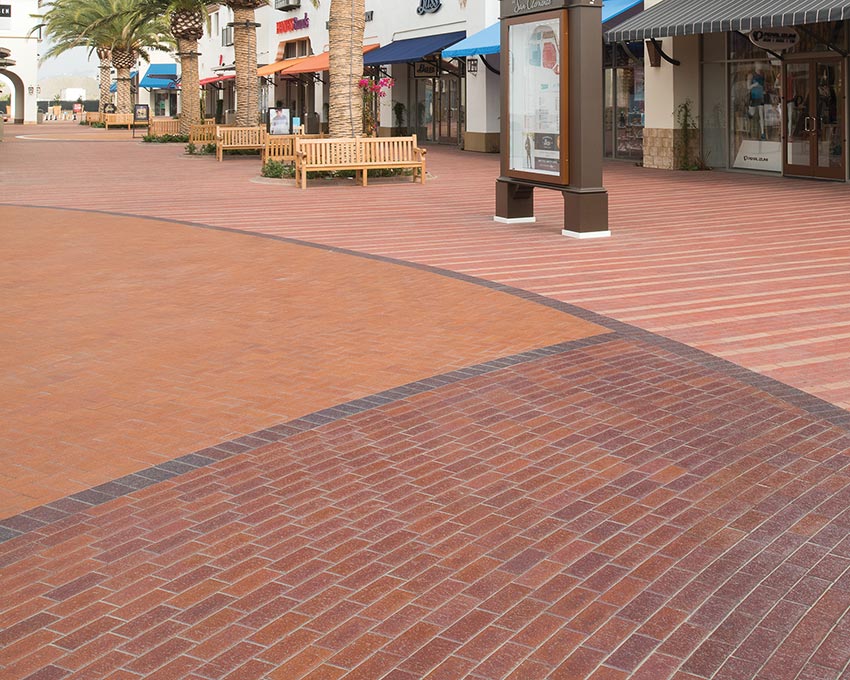
Photo courtesy of Endicott Clay
Multiple colors and patterns can help to humanize the pavement scale, as shown at this plaza in San Clemente, California.
Clay pavers provide the landscape architect with both quality material performance and design flexibility. Clay is an environmentally friendly raw material that has been used to fabricate bricks and clay pavers for hundreds of years. Clay pavers are fired at temperatures exceeding 2,000 degrees Fahrenheit. This process of firing provides designers with pavers that are non-fading and resilient to wear and staining. Because of this high-heat firing process, the pavers never need sealing to retain their color. And because there are no dyes used in the fabrication process, the cost of clay pavers is less than pavers comprised of other materials, such as concrete.
Design Flexibility: Variety in Color, Texture, Style, and Pattern
Clay pavers come in a variety of sizes and types, including permeable pavers, relieved edge lugged pavers, pool coping pavers, Danish hand-molded pavers, bullnose threads for stairs, and ADA handicapped detectible warning pavers. Clay pavers are used in both pedestrian and vehicular applications, including patios, pool decks and pool copings, large outdoor plazas, walkways, and driveways. The relatively small size of clay pavers creates a pavement surface with a human scale. The small size also allows for the nuances of different colors, textures and patterns to be clearly seen when standing from one vantage point within a pavement field.
Clay pavers are available in a wider range of colors. Due to the natural color of clay, the most common colors are the reds and browns of earth tones, but clay pavers are also available in buff, black, and gray. The color is typically consistent through the body of the paver, as it is fired in through the entire paver. Clay pavers are also highly resistant to weathering and fading due to their vitrified composition. As clay pavers are made from natural materials, there may be inherent color variations in pavers due to different production runs. For designers, the color variations from the different production runs can be mitigated in the field pattern. Using different colors helps to break down the scale of the very large pavement areas. Borders can be laid in a different color from the field, thus adding interest to the design. Patterns that flow, repeat, and intertwine can also be added.
The texture for pavers and paver treads is wire cut. Wire-cut brick pavers are formed by slicing a brick-sized piece with a wire tool from a larger bulk- length of clay. The clay is formed and fired as a large rectangular piece and then sliced into several small brick-sized pieces by pushing the wire-cutting tool through the clay. This slicing process by the wire cutter leaves a rough surface on the cured brick as it is pushed through the larger piece of clay. When the brick pieces are fired, the heating causes the rough surface to form cracks and crevasses, which provides the surface texture that is visually appealing to many designers and builders. The wire-cut rough surface texture provides more secure footing for pedestrians during rain events. Some clay pavers can also be manufactured with a dimpled surface to serve as tactile/detectable warning strips required for ADA compliance at crosswalks.
Pavement texture can be created not only by the surface texture but also by the treatment of the edges. Clay paver edges can be square, round, beveled, or relieved. Edge treatments can be uniform along the entire paver edge, or they can be variable, such as with pavers that are made to look historic. Fired pavers can also be tumbled to create “distressed” edges.
Due to their size, clay pavers provide great flexibility in the creation of pavement patterns. The most popular patterns are herringbone bond, running bond, stack bond, and basket weave. Pavement patterns should be selected based on the horizontal loads to be received and the proposed setting bed. Setting beds of sand and bituminous are the most prone to horizontal movement or paver creep, so a herringbone bond pattern would be more appropriate for these types of setting beds, as this pattern best distributes horizontal forces, thus reducing the potential for paver creep. Patterns with continuous joints (running bond) do not distribute horizontal loads as well, and when using these patterns, they should be oriented perpendicular to the direction of traffic to reduce the possibility of paver creep.
Permeable clay pavers have half-inch ridges around the edges. These ridges maintain the joint spacing between the pavers. The joints as well as the subbase under the pavers are filled with crushed stone. Stormwater will run off the paver surface into the joints and percolate down into the subbase of crushed stone, eventually permeating down through the subgrade into the groundwater table.
In segmental paving applications, chippage can occur when pavers move against each other. This is usually due to improper installation techniques. When paver spacers are used along the edges of clay pavers, the chippage issue is eliminated. The paver spacers create and ensure the needed spacing between each paver to accommodate jointing sand while providing the crisp appearance of square edge pavers. Paver spacers come in both cross and T configurations. Each side of the spacer measures 1¾ inches high by 1 inch wide by 3⁄32 inch thick. There are four sides or segments to the cross-style paver spacer and three sides or segments to the T style.
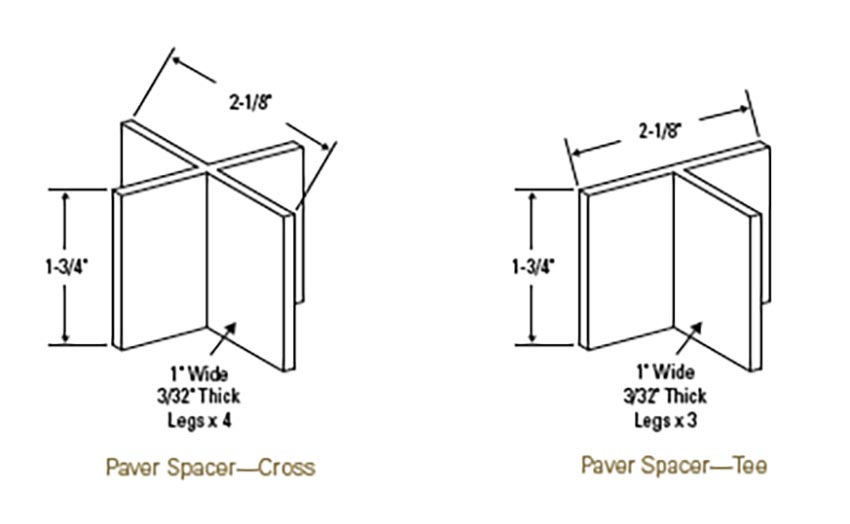
Images courtesy of Endicott Clay
Shown are two styles of paver spacers.
Construction and Design Standards for Clay Pavers
When designing an outdoor space using clay pavers, the designer must consider the intended use of that space and select the appropriate type of paver and detail the appropriate construction application and setting bed. ASTM provides standards for pavers depending on the intended use. Pavers manufactured in the United States must comply with consensus standards published by ASTM International. Two ASTM standards provide the requirements for clay pavers for exterior use: ASTM C902: Standard Specification for Pedestrian and Light Traffic Paving Brick and ASTM C1272: Standard Specification for Heavy Vehicular Paving Brick.
The pavers meeting ASTM C902 are suitable for patios, walkways, interior floors, plazas, residential driveways, and commercial driveways. There are three applications that help to define pavers based on the intended use. These application designations limit the dimensional tolerances, distortion, and extent of chipping. Application PS pavers are intended for general use and can be installed in any bond pattern with either sand-filled or mortared joints. Application PA pavers are generally used in many historic paving applications and where an architectural character is desired. Application PX pavers have tighter dimensional tolerances, thus allowing consistently narrow joints between the pavers.
Pavers meeting ASTM C1272 standards are used in areas that will receive heavy vehicular traffic, such as streets, commercial driveways, and industrial applications. There are two types of pavers depending on the method of installation. The type is based on the compressive strength, breaking load, and absorption properties. Type F pavers are set in sand setting beds with sand-filled joints, can be installed over flexible or rigid bases, and are required to be no less than 25/8 inches thick exclusive of chamfers. Type R pavers are used in mortar setting beds with mortar joints over a concrete base but can also be set on a bituminous setting bed with sand-filled joints. Their minimum thickness is 21⁄4 inches. The three applications of PS, PX, and PA are also common to ASTM C1272 standard pavers. However, ASTM C1272 pavers must be without cores or perforations. The Brick Industry Association provides a series of Technical Notes that elaborate in detail regarding the property requirements of clay pavers (www.gobrick.com).
The intended use of the area designed for clay pavers will dictate the appropriate setting bed. Setting beds provide a means of adjusting paver height, as there can be slight dimensional variations in pavers. Setting beds can be of sand, bituminous, or mortar depending on whether the area is intended for pedestrian and light vehicular use or heavy vehicular use. The setting bed supports the pavers and distributes the load to the base material. Bases can be of aggregate, asphalt, cement-treated aggregate, or concrete, again depending on the intended use and application of the clay pavers.
Winter Maintenance Considerations
For maintenance in cold climate areas, snow removal and de-icing applications should be evaluated for areas designed with clay pavers. Blades on snow equipment should be set high enough so as not to scrape the pavement surface in a manner that causes chipping. Rubber or urethane blade edges can also be used. If snow is intended to be stockpiled onto areas with clay pavers, the load capacity of the pavement must be adequately designed. There are a number of chemical products available for preventing and removing ice from pavements. Calcium magnesium acetate and urea are products that perform well and reduce potential staining of the pavement surface. Calcium magnesium acetate performs more effectively at lower temperatures. Rock salt is not recommended as it contains calcium chloride, which may cause efflorescence on the pavers.
Clay pavers can be laid over hydronic snowmelt systems, which eliminates the need for ice-melt applications and, in some cases, can eliminate the need for plowing or snow clearing. Hydronic snow-melt systems consist of plastic tubing networks that are laid below the pavers, usually cast into a concrete slab. Sometimes the tubing is incorporated into the bedding material underneath the pavers. A heated liquid is pumped around the tubing system during near- and sub-freezing conditions to maintain a pavement temperature that is slightly above freezing. This prevents the accumulation of snow and ice
Clay Pavers for Special Applications and Conditions
Clay pavers can be used to cover suspended decks and can also for permeable paving systems. When used as a pavement surface on a suspended deck, the designer must consider the prevention of water penetration into the structure and must deal with elastic deflections. A waterproof membrane should be designed into the structural slab to prevent water penetration. Horizontal drainage mats with a 2 percent slope will help with water drainage.
If the structural slab is located over a habitable space, insulation may be required to prevent heat loss in the building. Both foamed concrete and extruded polystyrene have been used for insulation layers depending on the application and intended use of the structural slab.
Clay pavers can be used when permeable pavements are required to reduce or delay stormwater runoff into drainage systems or for use in environmentally sensitive areas. The permeability in the surface is achieved by creating wider joints that are filled with permeable aggregate in place of sand. The pavers are also laid over a permeable setting bed and base of aggregate and stone. The water can thus penetrate through the joints into the base layer and be stored in the base layer until it infiltrates into the subgrade.
Special clay pavers with a dimpled surface cast into them provide a tactile warning surface in walkways and along streetscapes where ADA-compliant tactile warning strips are required. The smaller size of the clay pavers provides a great deal of design flexibility in the location and size of the tactile warning area. The Harley Avenue Streetscape in Fort Worth, Texas, provides an example of dark-grey-colored, dimpled-surface clay pavers used to create tactile warning strips that help challenged users identify the locations of bollards in the plaza designed with clay pavers.
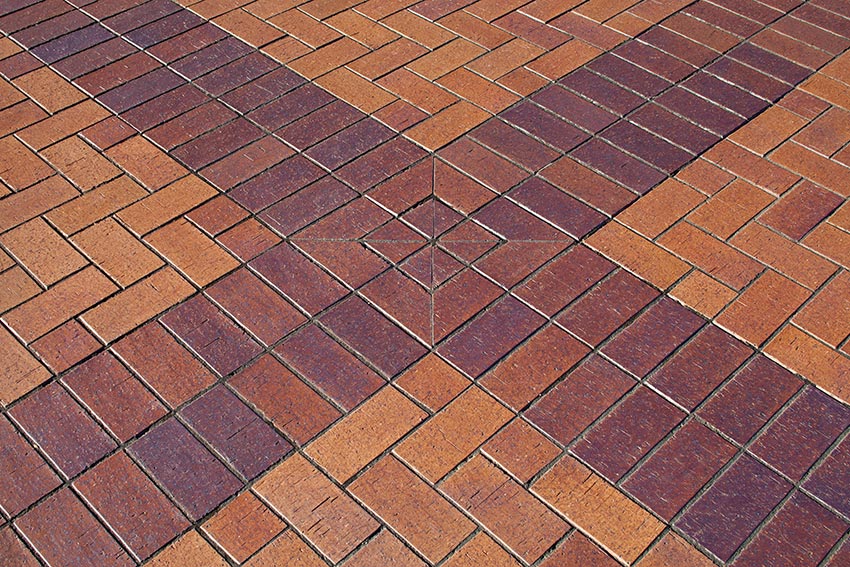
Photo courtesy of Tilley Interests
ADA-compliant clay pavers provide tactile warning strips at the Harley Avenue Streetscape in Fort Worth, Texas.
Clay pavers can be used in a wide range of applications, and the variety of textures and colors they provide gives designers a number of options for creating inviting and durable pavement surfaces. As clay is a natural material, it meets LEED and SITES criteria that provide points for regional materials. Those clay pavers that are used for stormwater management help to meet LEED criteria 6.1 and 6.2 for Stormwater Design. And using clay pavers in creating plazas, walkways, patios around building exteriors, and streetscapes will provide designers with possible points for LEED Pilot Credit 14: Walkable Project Site, LEED Pilot Credit 78: Design for Active Occupants, and SITES criteria 6.4, 6.5, and 6.6 under Human Health and Well-Being.
The Overall Benefits of Outdoor Spaces
There are a number LEED, SITES, and WELL certification strategies that can have a positive impact on the health and well-being of a building’s occupants. Outdoor spaces such as plazas, roof gardens, and outdoor decks that are easily viewed and accessible from a building interior benefit building users and occupants while also providing LEED, SITES, or WELL credits.
Wood decking, clay paver surfaces, metal and wood planters, and wood tile roof systems are products that provide designers with multiple options for landscape architectural place making. These products that are sustainably produced and transported can help designers meet LEED, SITES, and WELL criteria focused on Materials Selection.
Outdoor spaces with surfaces that are light in color and have a high SRI and rooftop gardens that provide planters and areas for plantings help to reduce the heat island effect on a project, thus contributing to LEED and SITES points in the Site Design categories of those rating systems.
Outdoor spaces that provide opportunities for physical activity, social interaction, safe site accessibility, and equitable use of a site meet multiple criteria in the Human Health and Well-Being areas of the SITES rating system and also address goals of Mind, Movement, and Community in WELL certification. In addition, site designs that expand user opportunities outside of the building shell and provide an integrated, sustainable, human-focused approach to the project contribute to the design objectives of Whole Building Design.
End Notes
1 Cellulose is an insoluble substance which is the main constituent of plant cell walls and of vegetable fibers such as cotton. It is a polysaccharide consisting of chains of glucose monomers.
2 Hemicellulose is any of a class of substances which occur as constituents of the cell walls of plants and are polysaccharides of simpler structure than cellulose.
References
Note 14. Technical Notes on Brick Construction. The Brick Industry Association. May 2017. Web. 18 July 2019.
Elena M. Pascarella, RLA, ASLA is a practicing landscape architect, continuing education presenter, and consultant engaged in a private practice based in Rhode Island. The firm’s portfolio can be viewed at www.landscapeelementsllc.com.






